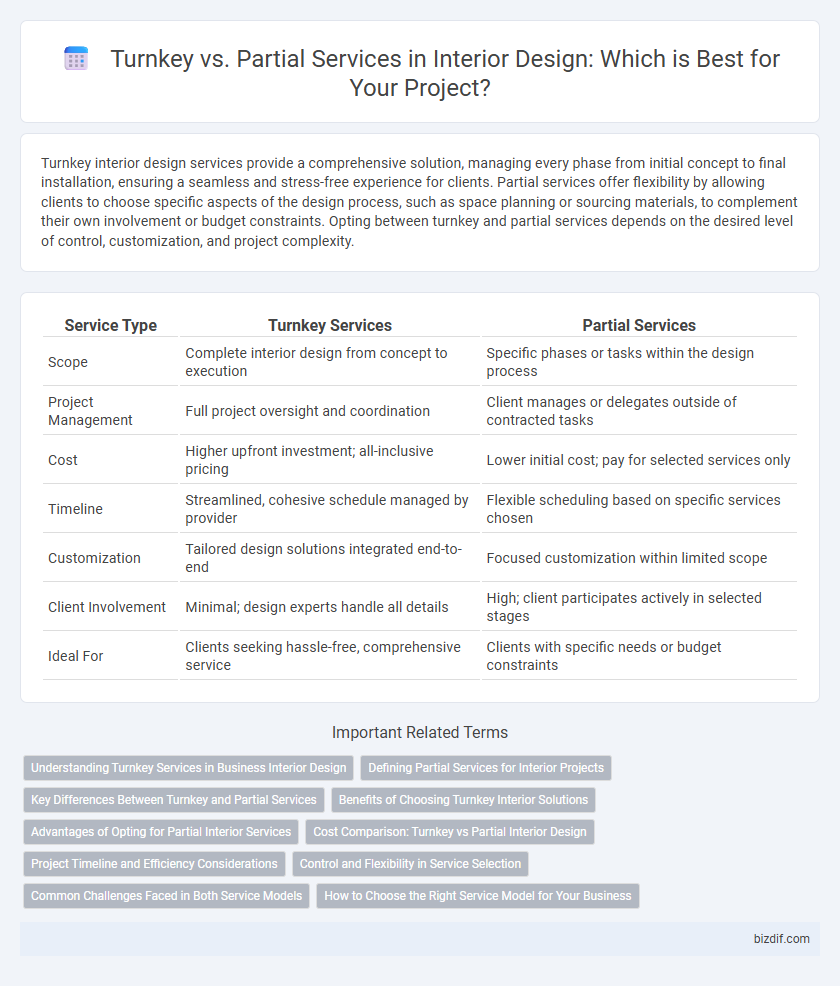Turnkey interior design services provide a comprehensive solution, managing every phase from initial concept to final installation, ensuring a seamless and stress-free experience for clients. Partial services offer flexibility by allowing clients to choose specific aspects of the design process, such as space planning or sourcing materials, to complement their own involvement or budget constraints. Opting between turnkey and partial services depends on the desired level of control, customization, and project complexity.
Table of Comparison
| Service Type | Turnkey Services | Partial Services |
|---|---|---|
| Scope | Complete interior design from concept to execution | Specific phases or tasks within the design process |
| Project Management | Full project oversight and coordination | Client manages or delegates outside of contracted tasks |
| Cost | Higher upfront investment; all-inclusive pricing | Lower initial cost; pay for selected services only |
| Timeline | Streamlined, cohesive schedule managed by provider | Flexible scheduling based on specific services chosen |
| Customization | Tailored design solutions integrated end-to-end | Focused customization within limited scope |
| Client Involvement | Minimal; design experts handle all details | High; client participates actively in selected stages |
| Ideal For | Clients seeking hassle-free, comprehensive service | Clients with specific needs or budget constraints |
Understanding Turnkey Services in Business Interior Design
Turnkey services in business interior design provide a comprehensive solution, managing everything from initial concept and design to procurement, construction, and final installation, ensuring a seamless, single-point-of-contact experience. This approach contrasts with partial services, where clients manage multiple vendors and coordinate separate phases, often requiring more time and effort. Turnkey solutions enhance project efficiency, reduce risk, and maintain cohesive design integrity throughout the entire commercial space transformation.
Defining Partial Services for Interior Projects
Partial services in interior design involve selective project phases such as space planning, material selection, or furniture sourcing based on the client's specific needs. These services allow for focused expertise and flexibility, enabling clients to manage certain aspects independently while outsourcing technical or creative tasks. Choosing partial services can optimize budget allocation and tailor customization in interior projects without committing to a comprehensive turnkey solution.
Key Differences Between Turnkey and Partial Services
Turnkey services in interior design provide a comprehensive solution, handling everything from conceptualization to final installation, ensuring a streamlined, hassle-free experience for clients. Partial services focus on specific phases of the project, such as design consultation or procurement, allowing clients more control and flexibility in managing certain aspects. The key difference lies in the scope and responsibility, with turnkey services offering full project management while partial services cater to customized involvement.
Benefits of Choosing Turnkey Interior Solutions
Turnkey interior solutions offer comprehensive project management, streamlining the process from concept to completion with a single point of contact, reducing stress and saving time. These services ensure cohesive design implementation, budget control, and high-quality finishes by coordinating all aspects including design, procurement, and installation. Clients benefit from guaranteed deadlines, professional oversight, and a seamless transition to a fully functional, styled space without the need for multiple contractors.
Advantages of Opting for Partial Interior Services
Partial interior services offer greater customization and control over design elements, allowing clients to tailor specific aspects without committing to a full project scope. This approach often reduces overall costs by focusing only on essential areas requiring professional input, making it ideal for budget-conscious homeowners. Flexibility in scheduling and selection of services ensures partial solutions align closely with individual preferences and evolving design trends.
Cost Comparison: Turnkey vs Partial Interior Design
Turnkey interior design services typically involve a fixed, all-inclusive cost covering everything from planning to execution, often leading to higher upfront expenses but streamlined budgeting. Partial services allow clients to selectively hire designers for specific tasks, resulting in more flexible but potentially unpredictable costs based on scope and fees. Comparing costs, turnkey solutions offer convenience and consistency, while partial services may reduce initial outlay but require careful management to avoid budget overruns.
Project Timeline and Efficiency Considerations
Turnkey services streamline project timelines by handling all phases from design to completion, reducing delays through integrated management and single-point accountability. Partial services may extend the duration due to coordination between multiple contractors and staggered responsibility, potentially impacting overall efficiency. Choosing turnkey solutions enhances schedule predictability and resource optimization, critical for meeting tight deadlines in interior design projects.
Control and Flexibility in Service Selection
Turnkey services provide clients with full control over the project timeline while minimizing decision-making stress, as the interior design firm handles everything from concept to completion. Partial services offer greater flexibility, allowing clients to select specific aspects such as space planning or material sourcing, thereby retaining more control over individual components. Choosing between turnkey and partial services depends on the desired balance between comprehensive management and personalized involvement in the design process.
Common Challenges Faced in Both Service Models
Turnkey and partial interior design services both face common challenges such as managing client expectations, coordinating multiple contractors, and adhering to strict project timelines and budgets. Ensuring seamless communication across diverse teams and adapting to unexpected site conditions also remain critical hurdles. Both service models require rigorous quality control to maintain design integrity and client satisfaction.
How to Choose the Right Service Model for Your Business
Choosing between turnkey and partial interior design services depends on your business goals, budget, and timeline. Turnkey services provide a seamless, end-to-end solution, managing everything from concept development to final installation, ideal for companies seeking efficiency and consistency. Partial services allow for greater customization by focusing on specific phases like space planning or procurement, suited for businesses that want more control over certain design elements or already have in-house capabilities.
Turnkey services vs Partial services Infographic

 bizdif.com
bizdif.com